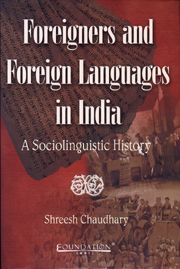Book contents
- Frontmatter
- Contents
- List of Annexes
- Notation Used for Transcribing Non-English Words, Names, Etc.
- Foreword
- Preface
- Acknowledgements
- 1 Introduction
- 2 Greek, Hebrew and Sanskrit
- 3 Arabic, Persian and Turkish
- 4 Armenian, Portuguese, Dutch and French
- 5 East India Company and The Indian Languages
- 6 East India Company and The English Language
- 7 Conclusion
- Index
5 - East India Company and The Indian Languages
Published online by Cambridge University Press: 26 October 2011
- Frontmatter
- Contents
- List of Annexes
- Notation Used for Transcribing Non-English Words, Names, Etc.
- Foreword
- Preface
- Acknowledgements
- 1 Introduction
- 2 Greek, Hebrew and Sanskrit
- 3 Arabic, Persian and Turkish
- 4 Armenian, Portuguese, Dutch and French
- 5 East India Company and The Indian Languages
- 6 East India Company and The English Language
- 7 Conclusion
- Index
Summary
Introduction
The British came to India relatively late. They followed the Portuguese and the Dutch but preceded the French and the Danish. The Honourable Governor and Company of Merchants of London, Trading into the East Indies, popularly known as East India Co (EIC), was formed and chartered in ad 1601. Their first trade mission arrived in Surat, in 1603. Until 1668, Surat remained their principal seat and factory. The first British ‘Ambassador’, Captain Hawkins (ad 1608–1613), reached the Court of the Mughal Emperor Jahangir in 1608. The first proper British ambassador, Sir Thomas Roe (ad 1613–1619), came here in 1613. The factory at Balasore came up in 1633. Until 1686, trade up to Hughli was the charge of this factory. Fort St George was created in Madras in 1640. The British got Bombay in 1688, and Fort William at Calcutta in Bengal was created in 1690. It was only by the end of the seventeenth century when the British established themselves in India.
The British were different from other Europeans in at least two respects. They were better focussed, and better organised. For the British, profit was the only goal, the only aim in taking the hazardous year-long voyage to India and the more hazardous stay here. One out of every five British who left their country never got back home – they died either on sea or in India, unable to bear its sun, its rains, its mosquitoes, its malaria, its diarrhoea, its cholera, and numerous other tropical diseases.
- Type
- Chapter
- Information
- Foreigners and Foreign Languages in IndiaA Sociolinguistic History, pp. 304 - 391Publisher: Foundation BooksPrint publication year: 2008



